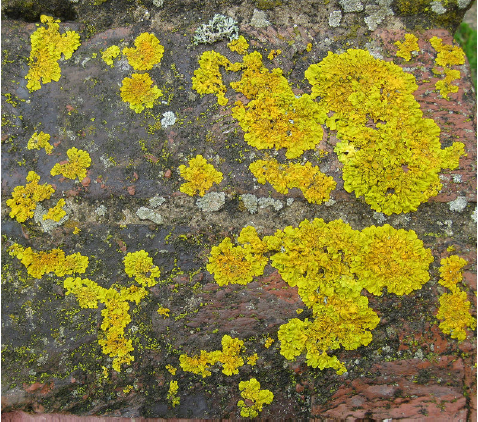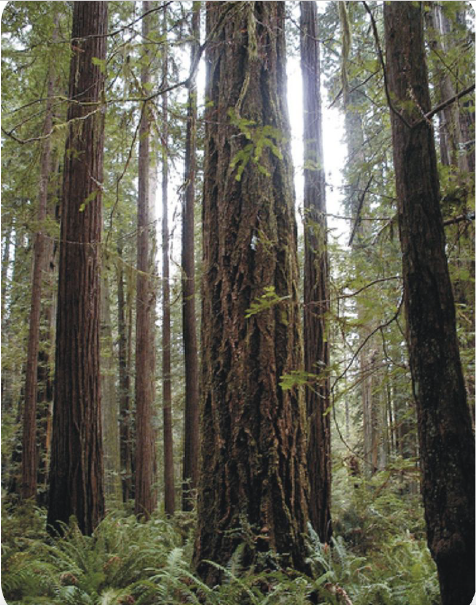Reading: Succession
Jessica Harwood
Douglas Wilkin, Ph.D.
http://www.ck12.org/saythanks
• Explain types of ecological succession and replacement within a community.
• Distinguish primary succession from secondary succession.
• Explain the role of a pioneer species.
• Define lichen.
• Summarize what is meant by a climax community.

What will happen to this land?
Since this land was clearcut, there is little life left behind. However, that does not mean that this land will stay barren forever. First little seedlings will establish themselves, and with time a forest could thrive here once again.
Succession
When you see an older forest, it’s easy to picture that the forest has been there forever. This is not the case. Ecosystems are "dynamic." This means that ecosystems change over time. That forest may lie on land that was once covered by an ocean millions of years ago. Lightning may have sparked a fire in a forest, destroying much of the plant life there. Or the forest may have been cut down at one point for agricultural use, then abandoned and allowed to re-grow over time. During the ice ages, glaciers once covered areas that are tropical rainforests today. Both natural forces and human actions cause ecosystems to change.
If there is a big ecosystem change caused by natural forces or human actions, the plants and animals that live there may be destroyed. Or they may be forced to leave. Over time, a new community will develop, and then that community may be replaced by another. You may see several changes in the plant and animal composition of the community over time. Ecological succession is the constant replacement of one community by another. It happens after a big change in the ecosystem. And, of course, succession occurs on brand new land.
Primary Succession
Primary succession is the type of ecological succession that happens on new lands—lands where life has not yet existed. Primary succession can take place after lava flow cools and hardens into new land, or a glacier recedes exposing new land. Since the land that results from these processes is completely new land, soil must first be produced. How is soil produced?
Primary succession always starts with a pioneer species. This is the species that first lives in the habitat. If life is to begin on barren rock, which is typical of new land, the pioneer species would be an organism such as a lichen ( Figure 1.1). A lichen is actually an organism formed from two species. It results from a symbiotic relationship between a fungus and an algae or cyanobacteria. The lichen is able to thrive as both the fungus and the algae or bacteria contribute to the relationship. The fungus is able to absorb minerals and nutrients from the rock, while algae supplies the fungus with sugars through photosynthesis. Since lichens can photosynthesize and do not rely on soil, they can live in environments where other organisms cannot. As a lichen grows, it breaks down the rock, which is the first step of soil formation.

FIGURE 1.1
Primary succession on a rock often begins with the growth of lichens. What do lichens help create?
The pioneer species is soon replaced by other populations. Abiotic factors such as soil quality, water, and climate will determine the species that continue the process of succession. Mosses and grasses will be able to grow in the newly created soil. During early succession, plant species like grasses that grow and reproduce quickly will take over the landscape. Over time, these plants improve the soil and a few shrubs can begin to grow. Slowly, the shrubs are replaced by small trees. Small trees then are succeeded by larger trees. Since trees are more successful at competing for resources than shrubs and grasses, a forest may be the end result of primary succession.
Secondary Succession
Sometimes ecological succession occurs in areas where life has already existed. These areas already have soil full of nutrients. Secondary succession is the type of succession that happens after something destroys the habitat, such as a flood or other natural disaster. Abandoning a field that was once used for agriculture can also lead to secondary succession ( Figure 1.2). In this case, the pioneer species would be the grasses that first appear. Lichen would not be necessary as there is already nutrient-rich soil. Slowly, the field would return to its natural state.
A forest fire can alter a habitat such that secondary succession occurs ( Figure 1.3 and Figure 1.4). Although the area will look devastated at first, the seeds of new plants are underground. They are waiting for their chance to grow. Just like primary succession, the burned forest will go through a series of communities, starting with small grasses, then shrubs, and finally bigger trees.

FIGURE 1.2
This land was once used for growing crops. Now that the field is abandoned, secondary succession has begun. Pioneer species, such as grasses, appear first, and then shrubs begin to grow.
Climax Communities
A climax community ( Figure 1.5) is the end result of ecological succession. The climax community is a stable balance of all organisms in an ecosystem, and will remain stable unless a disaster strikes. After the disaster, succession will start all over again. Depending on the climate of the area, the climax community will look different. In the tropics, the climax community might be a tropical rainforest. At the other extreme, in northern parts of the world, the climax community might be a coniferous forest. Though climax communities are stable, are they truly the final community of the habitat? Or is it likely that sometime in the future, maybe a long time in the future, the community of populations will change, and another stable, climax community will thrive?
Summary
• Ecological succession is the constant replacement of one community by another.
• Primary succession occurs in an area that has never before been colonized by plants and animals, while secondary succession occurs in an established area that was disturbed.

FIGURE 1.3
The early stages of succession after a forest fire are shown in these pictures. Taken four years after the fire, they show the charred remains of the original forest as well as the small grasses and shrubs that are beginning to grow back in the area.

FIGURE 1.4
In 1988, a forest fire destroyed much of Yellowstone National Park. This photo, taken 17 years later, shows that the forest is gradually growing back. Small grasses first grew here and are now being replaced by small trees and shrubs. This is an example of the later stages of secondary succession.

FIGURE 1.5
These ancient redwood trees are part of a climax community, the end result of a series of community replacements during succession.
Review
1. Define ecological succession.
2. What type of succession occurs in areas where there is no soil?
3. Imagine a forest fire destroyed a forest. The forest will slowly reestablish itself, which is an example of what kind of succession? Why?
4. How does primary succession usually begin? Give an example.
5. What is the end result of succession? Do these communities truly exist? Why or why not?
